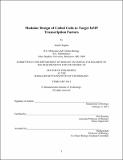Modular design of coiled coils to target bZIP transcription factors
Author(s)
Kaplan, Jenifer (Jenifer Brooke)
DownloadFull printable version (3.602Mb)
Alternative title
Modular design of coiled coils to target basic leucine-zipper transcription factors
Other Contributors
Massachusetts Institute of Technology. Department of Biology.
Advisor
Amy Keating.
Terms of use
Metadata
Show full item recordAbstract
Basic leucine-zipper (bZIP) transcription factors regulate many important cellular processes including tissue differentiation, stress responses and the unfolded protein response, the cell cycle, and apoptosis. Understanding the genes and processes regulated by bZIPs is imperative for understanding different diseases including diabetes and cancer, but there is still much unknown about how certain bZIPs function. Reagents capable of studying bZIP-regulated processes are therefore needed to specifically target the proteins under study. Recent work suggests that previous reagents, including siRNAs and dominant-negative bZIP mutants, may not have been as specific for the target bZIP as intended. In an effort to develop new reagents capable of specifically interacting with target bZIPs, I tested two protein design methods to determine whether they could successfully generate tight and specific binders of the leucine-zipper coiled-coil domain. Both methods tested take advantage of the structure and biophysical properties of a coiled coil. In the coiled-coil dimer, two helices wrap around each other into a super helix. At the sequence level, coiled coils have a repeating heptad sequence with seven positions denoted (a-b-c-d-e-f-g) and typically a hydrophobic residue at a and d positions. Due to a buried hydrophobic interface between the helices, individual coiled coils are unfolded in solution and only fold upon binding to a partner. The first method used to design peptides that would bind tightly and specifically to bZIPs depended on the coupled binding and folding within coiled coils. In a previous study, core positions of the peptide pointing inward to the coiled-coil interface were optimized for stably and specifically binding to the target, as these positions have been shown to be primarily responsible for specificity and affinity of interactions. The solvent-exposed positions were designed to complement the core positions. I measured the affinitiy and specificity of some of these designed peptides for their bZIP target. I then redesigned the solvent-exposed positions to include more helix-promoting residues that would increase the affinity of the interaction between the designed peptide and target bZIP. Using a solution FRET assay to test both the original and redesigned peptide's affinity for the target and 30 off-target bZIPs, I showed that redesigning the solvent-exposed positions did stabilize the design-target interaction from 3-fold to 90-fold but the redesign process also changed the specificity of the peptide. The second design method reduced the full coiled-coil interaction into interactions between individual heptads. Each heptad in the designed peptide was predicted to bind tightly and specifically to the corresponding heptad in the target bZIP. Using this design method, tight and very specific peptides were generated targeting different bZIPs and shown to be potent inhibitors. Finally, I proposed how these two methods can be combined to generate more tight and specific binders of bZIPs that can be used to reveal new insights into genes and cellular processes regulated by bZIPs.
Description
Thesis: Ph. D., Massachusetts Institute of Technology, Department of Biology, 2014. "February 2014." Cataloged from PDF version of thesis. Page 161 blank. Includes bibliographical references.
Date issued
2014Department
Massachusetts Institute of Technology. Department of BiologyPublisher
Massachusetts Institute of Technology
Keywords
Biology.